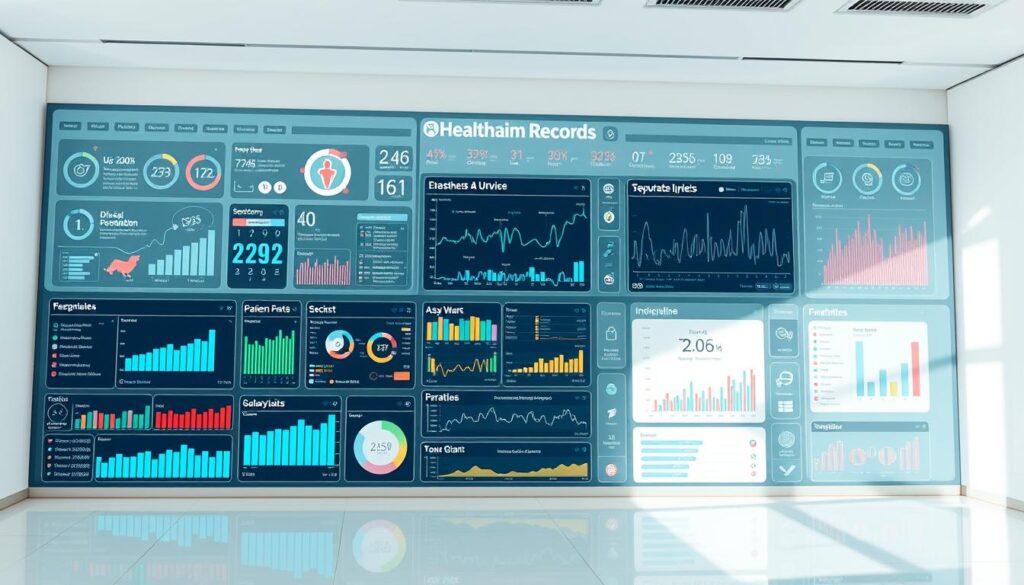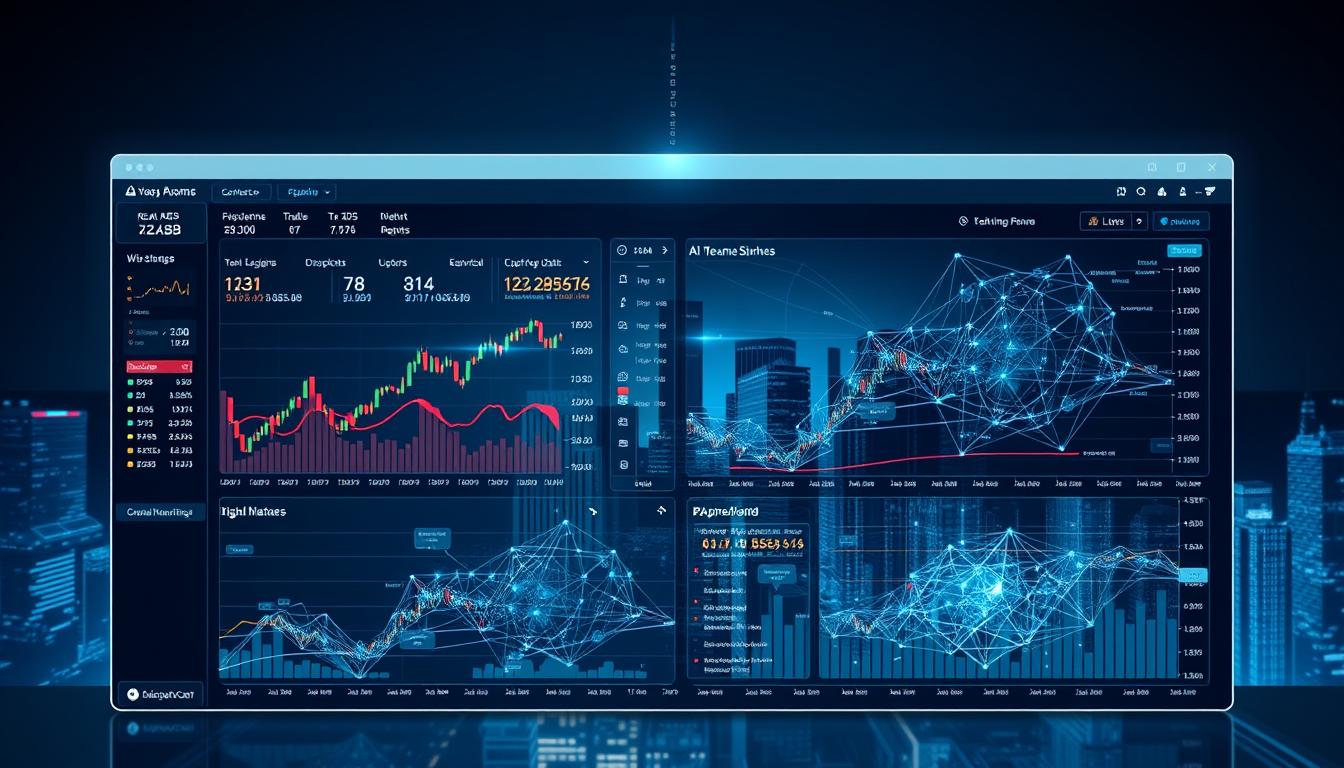Now Reading: Blockchain Healthcare Medical Records Management Solutions
- 01
Blockchain Healthcare Medical Records Management Solutions
Blockchain Healthcare Medical Records Management Solutions

The way we handle patient information is changing. Traditional systems often struggle with security and sharing data between different providers. This creates big challenges for giving the best care.
Distributed ledger technology offers a powerful new approach. It creates a secure, unchangeable log of information. This innovation can transform how we store and exchange vital health data.
This guide explores this exciting development. We will look at how it works, its real-world uses, and what the future holds. The goal is a system that puts patients in control while giving providers accurate, complete information.
Key Takeaways
- New technology is revolutionizing how patient information is stored and shared.
- Security and privacy are major benefits of using a distributed ledger system.
- This approach helps different healthcare providers access the same accurate data.
- Patients gain more control over their own personal health information.
- The system creates a transparent and reliable record of all medical events.
- Adoption is growing as the industry seeks better solutions for data handling.
Introduction to Blockchain in Healthcare
The staggering exposure of approximately 200 million personal health files between 2008 and 2018 highlights a systemic vulnerability in how we protect sensitive patient information. This alarming security landscape creates an urgent need for more robust solutions.
This innovative technology, first known for financial uses, is now addressing critical health sector challenges. The global market for these solutions is projected to hit $3.04 billion by 2025. Experts forecast it will grow to $11.04 billion by 2029.
This growth is driven by three key factors. They are pushing a fundamental shift from old, centralized systems to modern, decentralized networks.
| Primary Driver | Challenge | Technology Solution |
|---|---|---|
| Data Security | Preventing breaches and unauthorized access to sensitive files. | Creates an immutable, cryptographically secured ledger. |
| Regulatory Compliance | Meeting strict standards for storing and sharing personal data. | Provides a transparent and auditable trail of all access events. |
| Data Consistency | Ensuring all providers have the same, accurate information. | Enables a single, shared source of truth across organizations. |
Secure exchange of health data is the central application. This approach gives individuals more control. It also ensures providers have complete and accurate records.
Understanding Blockchain Technology in Healthcare
Digital ledger architectures introduce a novel approach to organizing critical patient information across multiple facilities. This framework connects hospitals, clinics, and laboratories through a shared blockchain network.
Blockchain Architecture Overview
Each piece of health data becomes an unchangeable block in the chain. These blocks contain unique cryptographic identifiers that reference previous and subsequent entries.
The write-once, append-only nature ensures information cannot be altered once validated. New data adds as additional blocks rather than modifying existing records.
Network members must endorse each transaction before creation of new blocks. This consensus mechanism maintains synchronized copies across all participants.
Public vs Private Blockchain Models
Three primary models exist for blockchain technology implementation. Public networks allow open participation like Bitcoin.
Private and consortium models restrict access to authorized entities. Controlled participation ensures only verified organizations join as nodes.
Cryptographic keys enable participants to edit designated portions securely. This prevents unauthorized alterations while maintaining system integrity.
Evolution of Medical Records & Digital Transformation in Healthcare
For decades, the primary method for tracking a person’s health history was pen and paper. These physical files were prone to being lost, damaged, or misfiled. They offered little protection for sensitive patient information.
The average person in the U.S. sees about 19 different doctors in their lifetime. This creates a scattered collection of nearly 19 separate health records. Having a complete picture of one’s health becomes very difficult.
From Paper to Digital
The move to Electronic Health Records (EHRs) was a major step forward. Digital systems made data easier to store and find within a single clinic or hospital. This improved workflow for healthcare teams.
However, a new problem emerged. Control over a person’s medical records often stayed with the providers. Sharing information between different hospitals could be slow. This delay sometimes affected the speed of treatment.
These early digital efforts showed that simply replacing paper was not enough. A more fundamental change was needed to put individuals at the center of their care. This need paves the way for next-generation solutions that address ownership and seamless access.
Benefits of Integrating Blockchain for Medical Records
Modern approaches to safeguarding sensitive health information through decentralized networks provide multiple strategic benefits. These systems deliver enhanced protection while improving how providers work with critical information.

The technology creates tamper-proof storage that significantly reduces unauthorized access risks. Cryptographic security makes data theft much harder than traditional systems.
Information integrity becomes guaranteed through immutable ledger technology. Providers gain confidence in the authenticity of all patient data. This prevents errors from outdated or incomplete records.
Authorized professionals can access complete health histories regardless of previous care locations. This eliminates information silos that compromise treatment quality.
Individuals maintain control over their personal information through permission systems. They can grant or revoke access while seeing who views their data.
Built-in audit trails and encryption help organizations meet strict regulatory requirements. The system ensures compliance with data protection standards while maintaining operational efficiency.
Key Features of Blockchain-based Health Records Management
Distributed ledger technology introduces several powerful features that redefine health information protection. These capabilities address critical weaknesses in older digital systems.
They create a foundation for more trustworthy and efficient handling of sensitive patient data.
Data Integrity and Immutability
A core strength is the creation of an unchangeable historical log. Once a piece of information is added to the chain, it cannot be altered or deleted.
This immutability is achieved through cryptographic hashing. Each new block of data securely links to the previous one.
It guarantees that health records remain permanent and accurate over time. This provides a single source of truth for all authorized users.
Enhanced Security Protocols
The system employs advanced cryptographic techniques to safeguard information. Data is encrypted and distributed across a network of computers.
This approach eliminates single points of failure that hackers often target. Every access request and transaction must be validated by network consensus.
This multi-layered protection makes unauthorized changes virtually impossible. It significantly boosts overall security for personal health information.
Other vital features include complete transparency with detailed audit trails. Patients gain direct control over who can view their records.
This empowers individuals within their care journey. The technology also enables seamless data exchange between different organizations.
This interoperability is a significant advancement, as highlighted in a recent analysis of health information systems.
| Feature | Traditional System Challenge | Blockchain Solution |
|---|---|---|
| Data Integrity | Records can be modified or corrupted. | Immutable ledger prevents alterations. |
| Security | Centralized databases are vulnerable. | Decentralized storage and encryption. |
| Patient Control | Providers manage access permissions. | Individuals grant and revoke access. |
| Interoperability | Data silos hinder information sharing. | Standardized protocols enable exchange. |
Blockchain healthcare medical records management: A Comprehensive Overview
A cohesive framework for managing personal health information unifies previously disconnected elements of the care journey. This integrated perspective shows how distributed ledger technology transforms the entire data ecosystem.
The process begins when a clinic enters new information through an Electronic Health Record (EHR) interface. This data is then validated by participants on the network before being permanently added.

Individuals interact with the system through secure authentication interfaces. They can grant access permissions and receive notifications when their information is viewed. This provides continuous visibility into one’s complete history.
For providers, the technology enables requests for comprehensive health histories. After receiving authorization, clinicians can access vital data and contribute new clinical documentation. This creates a seamless flow of information.
The architecture connects with various tools like patient portals and telehealth apps. It also integrates with laboratory systems for diagnostic data. This interoperability is a key strength.
| System Component | Primary Function | Benefit to User |
|---|---|---|
| EHR/EMR Interface | Captures initial patient data. | Streamlines clinical workflow for providers. |
| Patient Authentication | Controls secure access permissions. | Gives individuals control over their information. |
| Smart Contract Logic | Automates approval and logging processes. | Ensures consistent and transparent operations. |
Organizational implementation involves transitioning from legacy systems. Effective governance establishes rules for participation and maintains integrity across independent entities.
Smart Contracts and Security in Medical Data Transactions
Self-executing code now automates critical data exchanges between authorized parties in the health sector. These programmable smart contracts eliminate manual verification steps while maintaining robust security protocols.
When a provider submits new information through an EHR interface, the transaction requires network validation. Approved entries trigger automated contracts that create permanent data blocks in the distributed ledger.
Role of Smart Contracts in Healthcare
These automated agreements handle consent management with precision. Patients define specific access permissions that smart contracts enforce automatically.
The technology creates temporary authorizations for treatment episodes. It also revokes access when care concludes. This gives individuals complete control over their information.
Security features include cryptographic validation of user credentials. Every transaction attempt gets logged immutably, whether successful or denied.
Platforms like Ethereum use gas mechanisms to process data exchanges efficiently. This prevents network abuse while ensuring timely system performance.
Real-time alerts notify patients when providers view their information. This transparency builds trust in the entire healthcare ecosystem.
Ensuring Data Privacy and Compliance in Healthcare Using Blockchain
Protecting sensitive health information requires robust systems that balance confidentiality with accessibility. New technological approaches use advanced cryptography to create a secure environment for patient data.

Sophisticated encryption ensures that personal information remains confidential across a distributed network. Each participant can only edit the specific data for which they have explicit privileges.
This is managed through private keys. These unique cryptographic credentials give individuals control over their records.
Patients can grant access to specific portions of their history for defined time periods. This granular control supports the principle of minimum necessary disclosure.
Meeting regulatory standards like HIPAA and GDPR presents unique challenges. The immutable nature of the ledger must align with requirements for data deletion.
Solutions often involve storing detailed information off-chain. The ledger then holds secure pointers to this data, enabling compliance.
| Regulatory Framework | Primary Focus | Technical Consideration |
|---|---|---|
| HIPAA (US) | Patient privacy and security standards | Implementing access controls and audit trails |
| GDPR (EU) | Data protection and “right to be forgotten” | Using off-chain storage solutions |
| FDA Regulations | Safety and efficacy of medical devices | Ensuring data integrity for clinical evidence |
These systems provide a transparent audit trail for all access events. This strengthens security and simplifies demonstrating compliance during audits.
Managing Interoperability Challenges with Blockchain Solutions
The inability of different electronic systems to communicate effectively remains one of the most significant barriers to coordinated patient care. Traditional platforms use varying technical architectures and clinical terminologies. This fragmentation prevents seamless information sharing across organizations.
Currently, providers exchange health information through three primary models. The Push model sends data from one provider to another. The Pull approach involves requesting specific information. View access allows providers to see data within another system’s records.
Distributed ledger technology introduces a fourth model for data exchange. This approach enables direct peer-to-peer sharing without intermediaries. Organizations can join networks without building custom interfaces between entities.
| Interoperability Approach | Traditional Method | Blockchain Solution |
|---|---|---|
| Data Standards | Proprietary systems with incompatible formats | Common protocols adopted by all participants |
| Information Exchange | Requires custom interfaces and intermediaries | Direct sharing through standardized networks |
| Semantic Consistency | Varying clinical terminology causes confusion | Structured data elements maintain meaning |
| Implementation | Point-to-point integration projects | API connections to existing systems |
Patients benefit from complete health histories available to all authorized providers. This ensures coordinated care regardless of which organizations deliver services. The technology maintains performance while accommodating growing participation.
Cost Implications and ROI for Blockchain Implementations in Healthcare
Adopting new technology for patient information requires careful financial planning. Organizations must weigh the initial investment against the long-term operational expenses.
The total price depends on several key factors. These include the number and complexity of software features. The extent of integration with existing IT systems also plays a major role.
Choosing a network type significantly impacts the budget. A private setup often demands substantial infrastructure investment. Consortium models, however, can spread the costs across multiple partners.
Scalability is another critical consideration. Storing large volumes of data, like medical images, presents a storage challenge. The system must balance performance needs with these growing expenses.
| Cost Category | Key Drivers | Financial Impact |
|---|---|---|
| Development | Feature complexity, security requirements, regulatory compliance | High initial investment for robust, secure builds |
| Operational | Cloud hosting, transaction fees, maintenance, user training | Ongoing expenses necessary for system uptime and support |
| ROI Potential | Reduced breach costs, improved efficiency, automated processes | Long-term savings and competitive advantages |
Meeting strict security and compliance standards adds to the implementation price tag. A phased approach helps manage financial risk. Starting with a proof-of-concept validates the technology before a full-scale rollout.
The return on investment can be substantial. Potential benefits include lower data breach expenses and smoother information sharing. This leads to better operational efficiency and higher patient satisfaction.
Real-World Use Cases and Success Stories in Blockchain Healthcare
Several pioneering organizations have moved blockchain from theory to practice in medical settings. Their implementations demonstrate tangible benefits for patient data security and accessibility.
The MedRec project by MIT and Beth Israel Deaconess Medical Center represents a significant advancement. This system enables secure access to electronic health records across multiple stakeholders.
Patients receive alerts when data transactions occur. They maintain granular control over third-party access to their personal information. This approach puts individuals at the center of their care journey.
Patientory’s commercial platform shows how blockchain solutions integrate with existing infrastructure. The service stores medical records securely while connecting users with similar health challenges.
Its compatibility with major EHR systems like Epic and Cerner demonstrates practical interoperability. This avoids the need for complete healthcare IT replacement.
The IBM Watson Health and FDA partnership focuses on oncology data exchange. This high-profile collaboration explores secure aggregation of clinical trial information and genomic data.
These real-world examples validate blockchain‘s utility for addressing critical healthcare challenges. They provide confidence for organizations considering similar technology adoption.
Future Trends: Scalability and Technological Advancements in Blockchain
The next generation of ledger technology must overcome significant data handling limitations to achieve mainstream implementation. Current distributed systems face immense challenges when managing comprehensive personal information across multiple organizations.

Off-chain storage solutions represent the primary approach for addressing these constraints. Hybrid architectures store large files in separate systems while maintaining access controls on the main ledger. This balances security with practical storage needs.
Transaction throughput improvements are also critical for system performance. Advances like sharding and layer-2 solutions will dramatically increase processing capacity. Enhanced consensus mechanisms will support faster validation times.
| Current Limitation | Future Solution | Expected Impact |
|---|---|---|
| Storage Capacity | Off-chain data management with blockchain access controls | Reduced network burden while maintaining security |
| Transaction Speed | Sharding and improved consensus algorithms | Faster processing for time-sensitive applications |
| Interoperability | Cross-chain protocols and standardized frameworks | Seamless data exchange across different networks |
| Analytics Integration | AI and machine learning capabilities | Advanced insights while preserving privacy |
Platforms like Hyperledger Fabric and Ethereum 2.0 offer enhanced performance features. These specialized networks provide better governance and privacy controls. Regulatory frameworks are evolving to support these technological advances.
Cross-chain communication protocols will enable different systems to interact seamlessly. This interoperability allows information to flow across organizations and regions. The integration of artificial intelligence will unlock advanced analytics capabilities.
Integrating EHR Systems with Blockchain for Advanced Health Data Management
Bridging traditional EHR infrastructure with innovative ledger technology creates a powerful synergy for enhanced data management. This integration connects established platforms with modern distributed networks through API interfaces and middleware layers.
Organizations can leverage their existing investments while gaining advanced security features. The approach connects electronic systems with patient portals, telehealth applications, and laboratory platforms.
Streamlining Patient Data Access
Unified authentication mechanisms eliminate redundant login processes across different platforms. Individuals gain single-point access to their complete health history from multiple providers.
Real-time synchronization ensures all authorized users see the most current information. This creates a seamless experience for both patients and care teams.
Leveraging Off-chain Storage Solutions
Distributed networks efficiently manage access controls while large files store separately. Medical images, documents, and sensor data reside in cost-effective external storage.
Cryptographic hashes on the main ledger verify data integrity without storing complete files. This hybrid architecture balances performance with security requirements.
Technical implementation uses JavaScript frameworks for development and containerization for deployment. Automation tools streamline operations while maintaining system reliability.
Overcoming Integration and Adoption Challenges in Healthcare Blockchain
Successfully deploying advanced ledger technology requires overcoming both technical integration barriers and cultural resistance within medical organizations. Healthcare providers often hesitate to adopt new systems due to workflow disruption concerns.
To accelerate user acceptance, development teams must create intuitive interfaces that simplify complex processes. Role-specific training programs help medical staff understand the system quickly. Comprehensive documentation tailored to different users reduces learning time significantly.
Technical integration presents another major hurdle. Connecting distributed networks with existing IT infrastructure demands careful API design. Thorough testing ensures reliable data exchange between different platforms.
Organizational psychology creates additional challenges. Many institutions view themselves as sole custodians of patient information. Change management strategies must address these cultural assumptions about data stewardship.
Starting with pilot projects builds confidence before full deployment. Phased rollouts demonstrate value while minimizing risk. Executive sponsorship and stakeholder engagement are essential for successful implementation.
Global Perspectives: Blockchain Adoption in Healthcare around the World
International adoption of decentralized networks for health data management reveals diverse implementation strategies across different regions. Each country adapts the technology to address specific national priorities and regulatory frameworks.
International Case Studies
Estonia pioneered one of the earliest implementations, partnering with Guardtime to secure electronic patient information. The nation issued one million personal identity smart cards, creating comprehensive audit trails while storing actual files off-chain.
The United Arab Emirates demonstrates ambitious national commitment through partnerships between telecom companies and care providers. Dubai’s government aims to migrate all official documents to distributed platforms, showing top-down support for the system.
Thailand takes a progressive legislative approach, amending electronic transaction laws to support smart contracts. The government developed specific privacy regulations for sharing personal data via cryptographic networks.
The United Kingdom’s Chief Scientific Officer recommended investment in distributed ledger solutions for the National Health Service. This highlights governmental interest in improving patient information sharing across the extensive public health infrastructure.
These global initiatives provide valuable lessons about technical architectures and governance models. They demonstrate scalability across different contexts and build momentum toward international interoperability.
Conclusion
As we stand at the intersection of technological advancement and patient-centered care, a new paradigm for data stewardship emerges. Distributed ledger innovations offer transformative solutions for longstanding challenges in information security and accessibility.
The compelling value proposition includes enhanced protection against breaches and seamless information sharing across providers. Patients gain unprecedented control over their personal health information, creating a more transparent care journey. These advanced technological applications demonstrate significant potential for improving operational efficiency.
While challenges around scalability and integration remain, ongoing advancements continue to address these obstacles. The projected market growth to $11 billion by 2029 signals strong industry confidence in this approach.
This technology fundamentally reimagines how we manage sensitive information. It establishes the foundation for secure, efficient systems that prioritize individual control while enhancing care quality across the entire ecosystem.
FAQ
How does blockchain technology secure patient information?
This technology secures patient information by creating an unchangeable digital ledger. Each transaction, like a new entry in a health record, is encrypted and linked to the previous one. This makes it extremely difficult for unauthorized users to alter or access sensitive data, protecting against data breaches.
What role do smart contracts play in managing health data?
Smart contracts automate and enforce rules for data exchange. For example, they can grant a doctor temporary access to a specific part of a patient’s record for a set time. This streamlines sharing between providers while maintaining strict control over personal health information.
Can blockchain systems work with existing electronic health record (EHR) systems?
A> Yes, they can be integrated. Blockchain acts as a secure layer on top of current EHR systems. It helps improve interoperability, allowing different systems from various healthcare providers to exchange information more reliably and securely without replacing the entire existing infrastructure.
Who controls access to my personal health records on a blockchain network?
You, the patient, have ultimate control. Using private keys, you decide who can see your information and for how long. You can grant permission to doctors, researchers, or insurers, creating a patient-centric model for health data management.
How does this technology address data privacy laws like HIPAA?
Blockchain’s design supports compliance by providing a transparent and auditable trail of all access and transactions. While the technology itself is secure, the applications built on it must be designed to meet specific regulations, ensuring that handling of patient data follows laws like HIPAA.
What are the main challenges for healthcare providers adopting this technology?
Key challenges include the initial investment cost, ensuring system scalability for large volumes of data, and training staff. Overcoming interoperability issues between different providers’ systems is also a significant focus for successful implementation.















